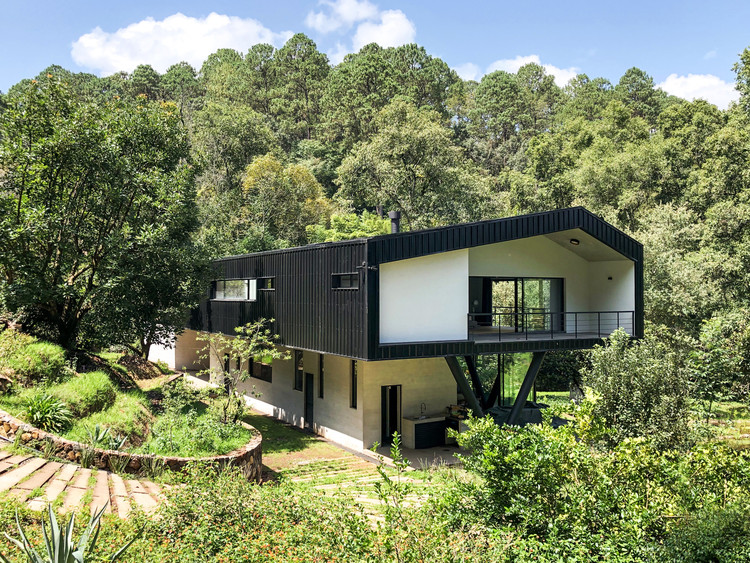
-
Architects: A-001 Taller de Arquitectura
- Area: 850 m²
- Year: 2020
-
Lead Architect: Eduardo Gorozpe

Text description provided by the architects. Ocoxal House is located in the forest bordering Valle de Bravo, 160 kilometres from Mexico City, on a 9,000m2 lot of land that functions as a productive microsystem and in which the house is integrated in a respectful manner.



The shape of the main house is born from a geometry of superimposed volumes through which the void is inhabited. The formal composition evokes the traditional houses in Valle de Bravo, the image of the cabin with a gabled roof proposes a reinterpretation of this iconography with a contemporary aesthetic achieved thanks to the black sheet on the facade, the concrete and the glass.



The upper volume contains the family's private living spaces, while the lower volume contains semi-private spaces, such as guest bedrooms. In the void generated by the intersection of these volumes, there are shared spaces that allow a relationship between the interior and the exterior, promoting contemplation of the wilderness and an understanding of the ecosystem. The project is not only a family leisure home but an exhaustive creative exercise focused on responding to all functional requirements and giving value to the whole, starting from observing and understanding the role of each element present in the space of this intervention.

Natural resources. For the client it was very important to inhabit a space that could generate life cycles with the environment, that is why the leitmotif of the project was to create a bridge with the territory, through the conservation and use of existing natural resources that will be a source of vitality for the vegetables and the fruit trees (all the existing trees on the property were preserved), as well as the bees and the chickens.



Water: Part of the characteristic composition of the lot is a ravine in which a river is located that feeds a hydraulic mill from which electricity is created, supplying 70% of the electricity of the house, a distribution network, an irrigation canal, wetlands, orchard areas, fruit trees and harvest gardens. The rainwater collection plant, which is filtered and destined to supply the hydrosanitary system, the pool and the irrigation of green areas. The water that is not used is returned to the river, generating 0% waste.

Thermal comfort: Passive bioclimatic control technologies were implemented with the intention of taking advantage of the natural resources of the environment and regulating the different factors that affect habitability and comfort, such as humidity and temperature. Twenty solar panels located on the roof are responsible for maintaining the warm temperature in the bathrooms and the pool.
It is possible to maintain a comfortable temperature throughout the year, even in winter, thanks to the Venturi natural extraction system and a ventilated facade system using ducts and interior and exterior vents.






















.jpg?1602708023)